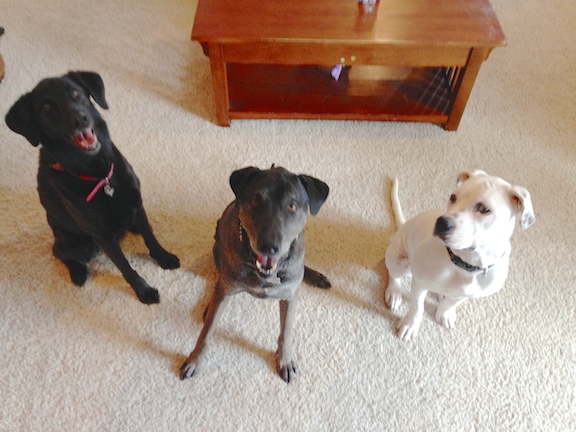Helping a Deaf Dog Join a New Pack
By: David Codr
Published Date: June 4, 2014
 Sadie and Oliver (left and center) got a new room mate recently, Penelope (right) a deaf, six month old American Bulldog. Their owner called me for help after a few fights between Sadie and Penelope.
Sadie and Oliver (left and center) got a new room mate recently, Penelope (right) a deaf, six month old American Bulldog. Their owner called me for help after a few fights between Sadie and Penelope.
When I arrived for the session, one of their owners was holding Penelope in the far end of the living room. She explained to me that she was scarred that there may be another fight as they seem to happen when Sadie or Penelope get near each other when either is too excited.
Whenever you have a pack of dogs, its important that the humans are perceived as clear, confident leaders. Without a clear hierarchy in place, its not uncommon for their to be some dust ups when a new dog is introduced to an existing pack of dogs. This is obviously more difficult when the new dog is deaf as some of the communication and warning sounds are not recognized.
As it turns out, aside from not going to the bathroom in the home, the dogs really didn’t have any rules or boundaries. The lack of these makes it easy for the dogs to think that there is no leadership in place. Additionally their owners allowed the dogs on the furniture which can cause some dogs to think they have the same authority as the humans in the home.
I suggested that the family incorporate some rules and boundaries to help the dogs see them as being authority figures. Once a dog perceives clear leadership, they usually find their place in the pecking order which stops things from getting confrontational or aggressive.
While keeping the dogs separated prevents any future fights, it does not allow the dogs to learn to live together. Interaction, even supervised, is crucial in social development.
I noticed that any time Penelope or Sadie were near one another that one of their owner’s immediately tensed up. If I can perceive that, the dogs most assuredly do as well. If Sadie perceives her owner’s discomfort in the wrong way, that can actually lead to a fight.
After demonstrating a few techniques and exercises with the dogs separately, I asked her owner to let them all in the living room together so I could observe them. Neither dog showed any aggression or signs or stress or discomfort. They had nice body language, no one was over excited or dominant, and they even moved out of each others way.
I have worked with dogs that had serious aggression issues. Tearing of flesh, muzzles, repeated visits to the vet, etc. For the length of the session I did not see any behavior or activity that led me to believe these dogs cannot live together peacefully.
Now it will be important to keep the dog interaction supervised and watch for any signs of stress or aggression. If they witness this, I advised them to immediately intercede. Just like humans, fights don’t start out of the blue. In the canine world, dogs usually make several attempts to express their discomfort before an attack takes place. We reviewed the usual warning signs as well as how to disagree and intercede when they arise.
It will be important for the dogs to see that their owners will not tolerate any aggression or unbalanced behavior. Since Penelope cannot hear, Sadie will need to learn to use other forms of communication. Because most dog communication is non verbal, this should not be too difficult to accomplish.
What these dogs need is time and practice being and interacting with one another. Their owner had already stayed walking Sadie and Penelope tougher which is a great activity to do with dogs who aren’t entirely comfortable with one another. As long as their human takes a leadership position and does not allow either dog to take a dominant or leadership position, the walk can help the dogs see each other as counterparts.
Luckily neither dog is aggressive. I surmise that the previous attacks were a result of over excitement combined with the disruption of adding a new dog to an existing pack. With time and supervision combined with the new rules and boundaries, Im confident these dogs will learn to not only tolerate each other, but eventually to see each other as members of the same pack.
Categorized in: Dog Behavior, Dog Psychology, Dog Training Omaha, Omaha dog training



